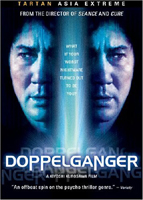 BUY IT AT AMAZON: CLICK HERE!
BUY IT AT AMAZON: CLICK HERE!
STUDIO: Tartan Video
MSRP: $24.99
RATED: R
RUNNING TIME: 107 Minutes
SPECIAL FEATURES:
• "Making-of" featurette
• Interview with director Kiyoshi Kurosawa
• TV spots and trailers
The Pitch
"It’s
The
Strange Case of Dr. Jekyll and Mr. Hyde meets Frankenstein in
The Humans
Director
Kurosawa’s constant muse Koji Yakusho (who also appeared in Memoirs
of a Geisha as businessman Nobu), Hiromi Nagasaku (who, IMDb says,
appeared as a judge in an episode of Iron Chef), and Yusuke Santamaria.
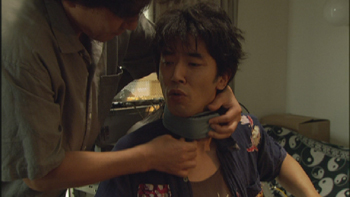
"Hey! The ad said B/G/G!"
The Nutshell
Michio
Hayasaki is a brilliant inventor working for a medical technology firm. His
latest project is the creation of a chair for invalids that would allow them to
function in society again. The chair has two robotic arms which are, at least
in theory, controlled by nothing more than the will of the operator. Think of a
battle-mech, and shrink it down so it looks a bit like Number 5 from Short
Circuit, and you’ve got a pretty clear idea.
The
problem is Hayasaki can’t seem to get the invention to work. There’s something
he’s missing. And, as he searches for what that is, and whether its a factor of
his own limited intelligence or a mechanical problem, something strange begins
to happen. He sees a man who looks exactly like him, who moves exactly like
him, who even wears the same clothes as him.
The
legend goes that if you see your doppelgänger,
somebody is about to die.
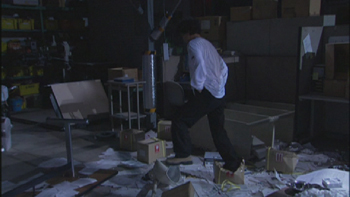
"Moon boots, moon boots, I wish I had moon boots."
The Lowdown
This
being a Kiyoshi Kurosawa film, such a legend doesn’t escape the plot unscathed.
Kurosawa has a hard talent for tugging at the metaphorical truth behind our
common fantasies, and in Doppelgänger he tackles the problem
of internally competing wills with a story reminiscent of Poe’s "The Cask
of Amontillado." He injects a bit of his own perspective, as well, turning
the film into a distinctly Japanese fable, speaking to a culture in which emotional
repression is the norm.
Inside
this framework, Kurosawa builds something that often resembles an old-fashioned
monster movie. Though this is part of the Asian Extreme brand from Tartan
Films, there’s nothing much to put Doppelgänger on a tonal level of,
say, Old
Boy or the other horror flicks in CHUD’s Clash of the Titans. The
melodramatic music, broad characterizations, and legion obsessions reminded me
of classic Frankenstein: a mad man in pursuit of a single goal, to the
exclusion of all else.
Though
the film hedges on light-hearted, the structure is anything but simple. As
Hayasaki approaches the realization of his project, the plot resembles a
gradual approach to a mirror. He and his doppelgänger exchange words, blows,
and, eventually, roles. The situations of the first half gradually dissolve as
Hayasaki fills the mirror’s vision and then, right around the midpoint, he
passes right through the looking-glass, fully assuming the aspects he loathed
in his double. The situations reappear in different forms, and the
relationships are reformed, albeit with new people filling the old roles.
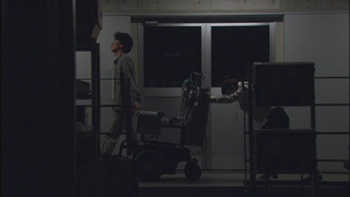
Think of it as a political cartoon.
As you
might expect, this crossing over brings a bit of a tonal change to the film.
It’s like the difference between
of the real world — which have been observed closely up until this point —
are casually ignored. The film abandons any pretense of being a thriller and
instead turns into a darkly comic series of mishaps, with more slapstick than
you’d ever expect in a J-horror picture.
Rather
than being WTF-inspiring, like the end of Miike’s Ichi the Killer,
Kurosawa’s purpose in pivoting so sharply seems an intention to serve the
film’s thesis. Hayasaki begins as an emotionally repressed, socially impotent
man, and the film technique mirrors his flatness of experience. At the
midpoint, when he begins to switch the sides of the mirror, Kurosawa surrounds
him with vibrant scenarios, violent and otherwise.
I think
that there are a few missteps in this latter section, especially as the
conclusion drags on through a comedy of errors. The pacing strains at the
audience’s emotional involvement with the characters. More irritating is the
strange sabotage of the spirit of gleeful anarchy. The film ends with Hayasaki
abandoning everything that bound him to his former life, except for one thing:
a boatload of cash. Though he is happy to break all ties to his former life, that
one symbol of societal dominance seems to ground him. I was left a little
confused about this — it seems strange to burn the metaphorical house down and
rescue something from it at the same time. Still, that’s only one piece of
cognitive dissonance in a third act that’s designed to screw with your
expectations.
Doppelgänger won’t necessarily attract fans of
the horror genre. It’s more a modern fantasy than anything else. It’s a
thoughtful film, as Kurosawa’s tend to be, but it’s much more vivid in
character and optimistic in spirit than his other works. It’s a dramatic shift
for the director of the soul-crushing despair of Pulse, but it works
reasonably well as a reaction to harmful repression for those who can stomach the mutable world it creates, along with
its somewhat taxing conclusion.
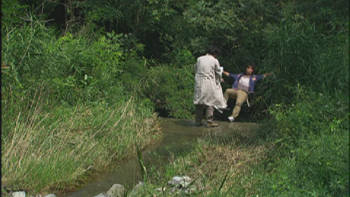
Cliff divers do it with panache. Sometimes.
The Package
It’s odd
to say it, but this is an instance of a DTS track that doesn’t improve the
quality of the disc. The sound design in Doppelgänger is a break from the
hyper-detailed tracks that Kurosawa tends to add to his movies; instead, the
effects are almost laughably dull (long before the humorous part of the film)
and pumping them out with the clarity of the DTS track just serves to emphasize
a weak aspect.
As far as
bonuses go, there’s nothing much unique. You get a trailer and TV spots, a
marketing "making-of" featurette, and a short, relatively
uninformative interview with Kiyoshi Kurosawa.
7.2 out of 10